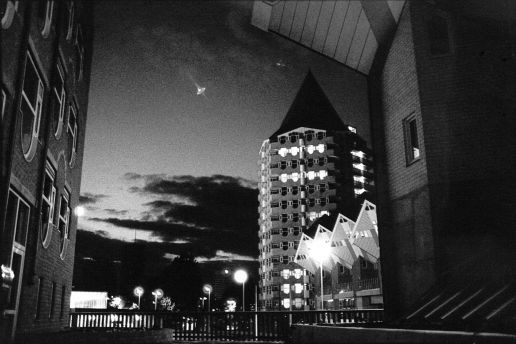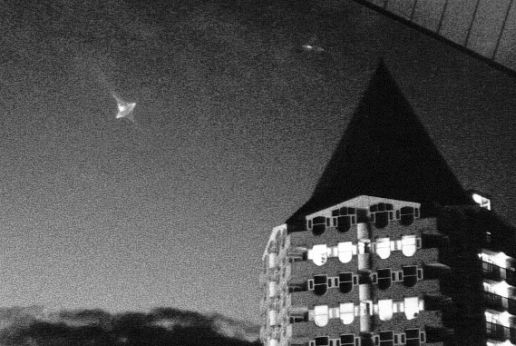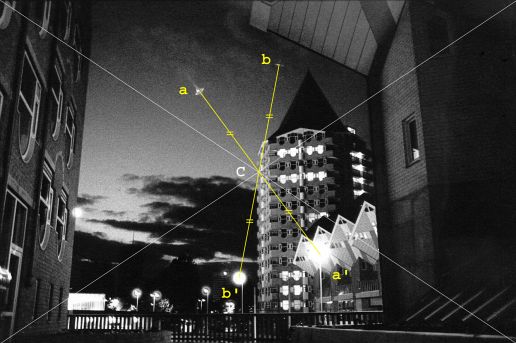On October 13, 1989, Dutch free-lance photographer R.N. sent the following letter to CAELESTIA correspondent Frits VAN DER VELDT:
Concerns: Picture of UFO
Dear Mr. Van der Veldt,
Enclosed you will find a picture I took in mid October 1984 in Rotterdam. When I show the picture to other people, I often encounter disbelief; maybe that will sound familiar to you. I am anxious to find out if you can tell me more about the phenomenon in the picture.
Kindest regards,
R.N.

In further correspondence with VAN DER VELDT, R.N. specified that the photo was taken with a Nikkor lens ("probably a 50 mm / f2") in combination with a Nikon UV filter and a Kodak tri-x 400 ASA black & white film. It was further emphasized that the picture was not a hoax and that nothing out of the ordinary was seen when the photo was taken.
Below is a close-up of the bizarre spindle-shaped UFOs. The 14 story apartment building on the right is known in Rotterdam as "Het Potlood" (The Pencil).

- Investigative report "UFO-foto boven Rotterdam medio oktober 1984" compiled by Frits VAN DER VELDT in 1989.
Luminous shapes that appear on photographs but went unnoticed when the photos were taken, usually have a very simple explanation: lens flares. These are internal reflections in the camera's lens system, caused by light sources that are in the camera's field of view.
Lens flares obey the optical laws of reflection and that is what makes it easy to identify them. This is one way to proceed: first we must be sure that the document we want to examine is a full frame version of the original picture (in case of non-digital imagery, it is advised to work with the original negative or slide; in any case, cropped versions cannot be used). Next we determine the centre of the picture by drawing two diagonal lines that connect the opposing corners (see white lines in the illustration below). Now we draw a line from the centre of each light spindle (a and b) through the picture's centre (c). Already note that these lines (coloured yellow in our example) run in the same direction as the axes of the spindles. To determine if the UFOs are indeed reflections of light sources in the picture, we now have to look for a bright light on each of the yellow lines in the opposite direction of the picture's centre and at the same distance from that centre. Our short test is a success: the two streetlights closest to the camera are located at exactly the right places (a' and b'), leaving no doubt that they are responsible for the spindle-shaped lights. This is also what Frits VAN DER VELDT concluded when he first analyzed the picture in 1989.

A simple analysis showed that the spindle-shaped lights in this picture are lens flares caused by street lights.


